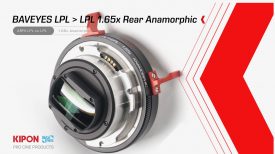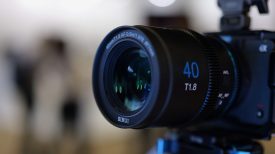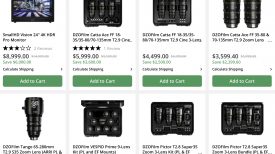
The Canon C200 is a new addition to the company’s Cinema EOS range of cameras. At a briefing last week Canon were adamant that it’s not a replacement for the C100 MkII, rather an upgrade path for C100 users who want more from their camera; and a potential B or C cam for C300 MkII and C700 users.
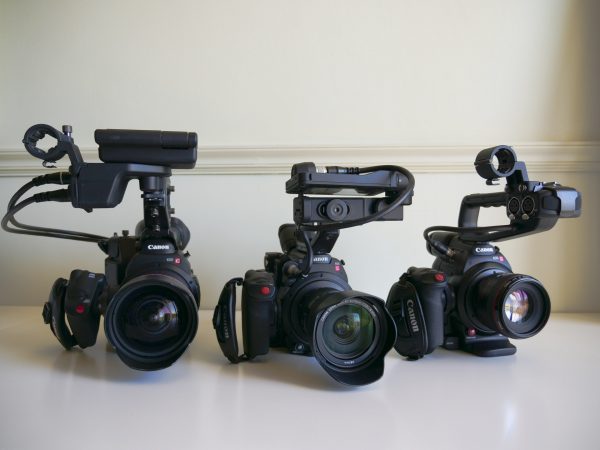
The EOS C200 integrates an 8.85 Megapixel Super 35mm 16:9 CMOS sensor that supports 4K (DCI) recording with a maximum resolution of 4096 x 2160 pixels. Canon told us at the C200 uses the same sensor from the C700 and includes C-Log and C-Log 3 profiles to ensure it’s as easy as possible to match footage from other C-series cameras. Yes, Canon are apparently putting the sensor from their flagship, very expensive Super 35 camera into a more budget-friendly model. It seemed so unlikely I thought I’d made a mistake in my notes but I’ve since double checked and Canon have confirmed. At this stage I will have to take their word on it, but the specifications sheet Canon sent out states that the camera uses a 9.84MP 4206×2340 (total pixels per sensor) Super 35-sized sensor and the Dual DIGIC DV6 image processor. On paper this is the size of the sensor that is found in the C300 Mark II, and is slightly smaller than the 11.54MP 4622 x 2496 (total pixels per sensor) found in the C700. The camera uses the image data delivered by this 4K CMOS sensor to also enable over sampling HD Processing for 2K (DCI) and Full HD 1080/60p recording.
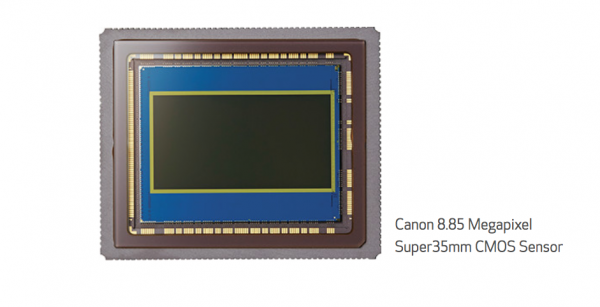
Each pixel in this CMOS imaging sensor also maintains a wide pixel pitch to maximise the amount of light that falls on to each photo site, which Canon claims should enhance the EOS C200’s sensitivity while also minimizing noise and supporting ISO speeds of up to 102,400. According to Canon the sensor also reduces data-readout time, which should result in a reduction in rolling-shutter artifacts.
C200 hands-on impressions
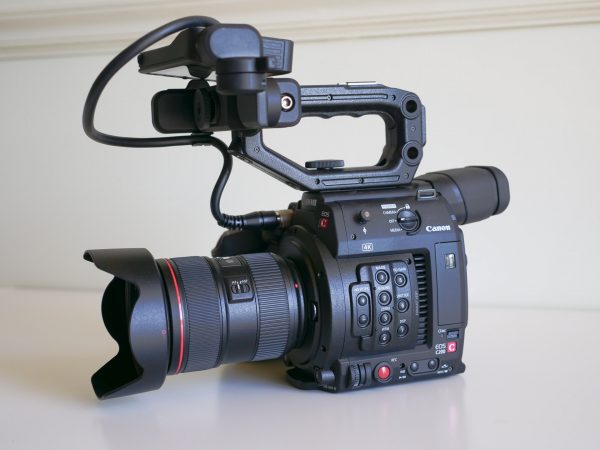
In the hand the C200 feels substantial and is closer in size and weight to the C300 MkII than the C100 MkII. There are a few changes though, and mostly for the better. The handle is much improved over both previous models, and features a double locking mechanism: one quick release and an extra bolt you can tighten with an allen key. The C200 I picked up was only secured via the quick release and it felt rock solid. Not a feeling I’ve ever had using the stock C300 MkI handle.
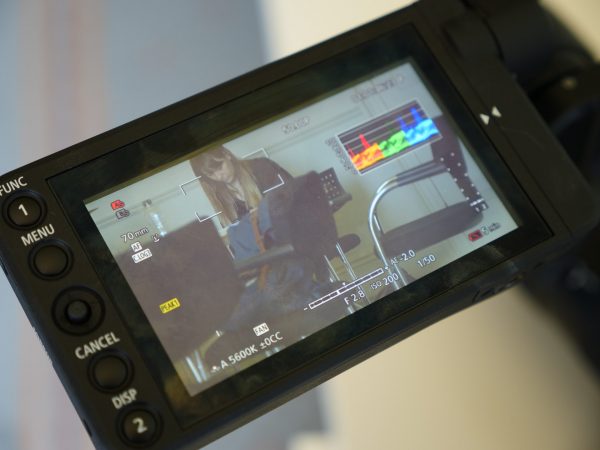
The clamshell from the C300 Mk II is gone, the monitor is new, and is now a fully adjustable and detachable, 1.23 million dot, 4-inch touch screen LCD Monitor that works with Canon’s Dual Pixel AF. The nice part about the new screen is that it enables one-finger “tap-focusing” during shooting. It seemed responsive and accurate in the very short time I had to try it out. It also seemed nice and sharp, though I wasn’t able to take it outside to see how viewable it was in sunshine.

A newly developed menu function has been added for Auto-Focus tuning, allowing easy access to camera and lens settings. The AF Speed Tuning function allows users to set the lens drive speed to any of 10 steps. AF subject tracking characteristics can also be varied and set to any of 7 steps, allowing the user to select the appropriate responsiveness when changes have occurred in the subject.
Up to 10 stops of ND
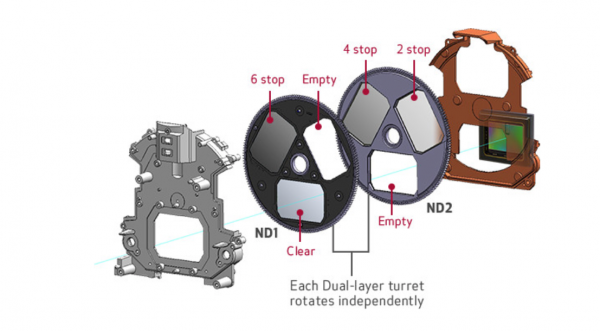
The C200 uses an internal, motorized ND assembly consisting of two rotating disks with glass ND filters between the rear of the lens and the front of the sensor. This combination of ND filters allows 5 steps of neutral density. In normal mode 2, 4 and 6 stops are available. In extended mode, 8 and 10 stops are also available. These are the same that are found in the C300 Mark II and are increased over the Clear, 2, 4, and 6 stop filters available on the C300 Mark I. This increase in the maximum amount of ND you can use will be beneficial for those shooters wanting to shoot at a very shallow depth of field even in bright, sunny conditions.
On-body audio controls
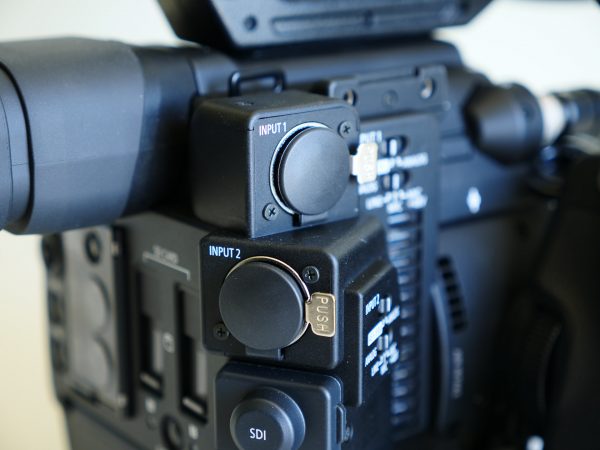
The monitor is connected via the same cable as is used on the C300 Mk II, and – frabjous day – only one cable is needed as XLR audio inputs have been moved to the camera body. We can’t have everything of course so they are in a slightly odd angled configuration at the back of the camera, but it’s a welcome change and one that suggests Canon has listened to criticisms of the earlier Cinema EOS models.
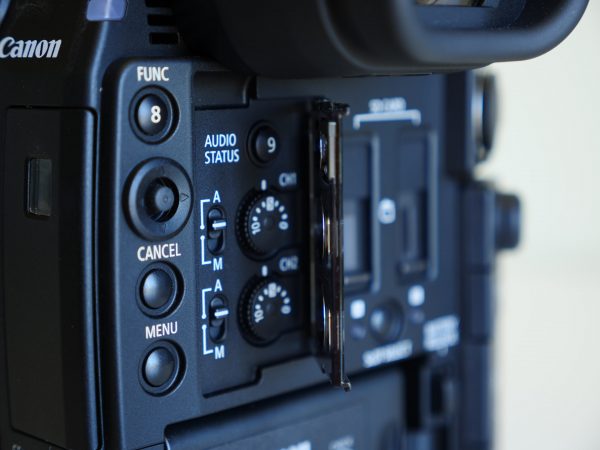
Cross-compatible accessories
The C200 is compatible with the C700’s V70 EVF, although if you do go down that route you’ll be spending an alarming proportion of the cost of the camera body on the EVF itself. However to each their own, and Canon say they are consciously trying to create an ecosystem of cross-compatible cameras and accessories. As part of that aim the C200 also uses the same batteries as the C300 Mk II.
Rosette attachment for control grip
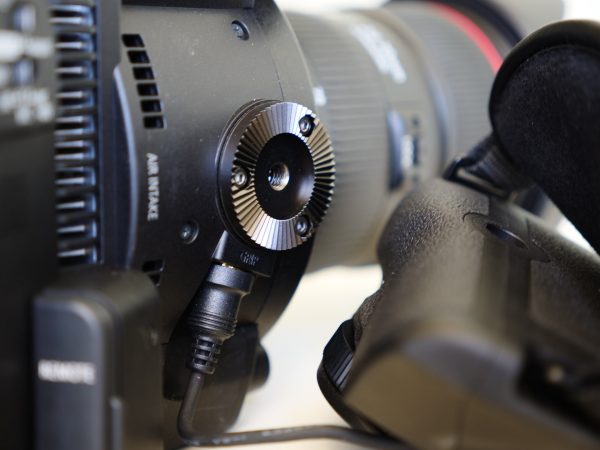
A small thing, but the control grip is now attached via a standard Arri-style rosette, making it much easier to relocate via third party accessories.
Canon Cinema RAW Light
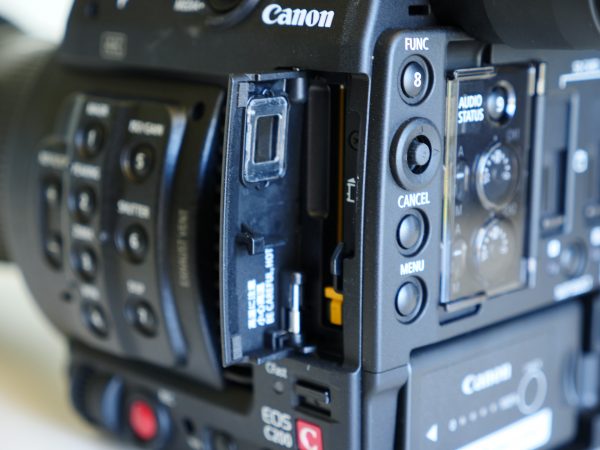
The C200 also introduces a new recording format: Canon Cinema RAW Light. Cinema RAW Light files are about 1/3 or 1/5 the size of Canon’s standard RAW files. The smaller file size and reduced bit rate speeds up data transfer and allows internal recording to CFast™ cards. Canon claim it will offer the “same flexibility in colour grading as Cinema RAW in a smaller file size.” Using it will make the most of the sensor’s dynamic range (a claimed 15 stops) but will be recordable internally. Using this mode means writing to a CFast 2.0 card and will allow 10bit (60fps) or 12bit (30fps) 4K DCI recording at a data rate of 1Gbps.
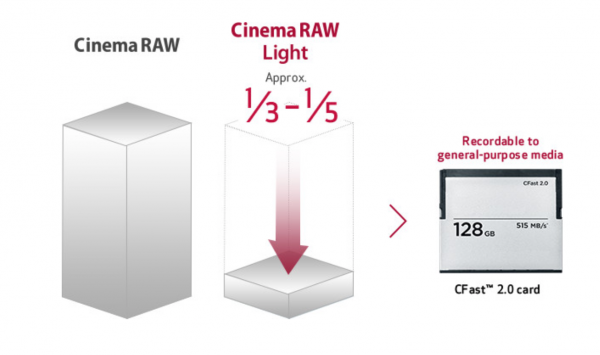
Canon say that from their testing they’ve been getting around 15 minutes of record time from a 128GB CFast 2.0 card. You can also record 2K proxies to the internal SD card slots at the same time.
Having the ability to record RAW (even if it is light version) internally without having to go to an external recorder is impressive for a camera at this price point. This is also going to be welcome news for those shooters who want to use the C200 on a gimbal or keep their camera size to a minimum.
But will it cut?
At launch the only confirmed NLE to definitely support Canon Cinema RAW Light natively will be Blackmagic’s Davinci Resolve. Cinema RAW Light files can be transcoded to other commonly used file formats, such as DPX or ProRes for later editing and online delivery using Canon’s CRD software. You’ll also be able to edit it in AVID, by using the Canon RAW plugin for AVID Media Access. Canon have also been working with Adobe and Apple. Apple have committed to supporting the codec ‘In a future version’ of FCP X. Edius have also said they will be adding support for the format during 2017.
And if you’d rather roll your own footage, Canon’s own Cinema RAW Development app will be updated so you can transcode to an edit ready format like ProRes yourself.
Hello MP4 my old friend
At launch the other means of recording available will be regular old MP4, with a claimed dynamic range of 13 stops. This will record UHD 4K at a data rate of 150Mbps, and HD at 35Mbps. Those weren’t figures high enough to set my pulse pounding but Canon justify them as a compromise worth making. Keeping the data rate lower allows the use of cheaper, widely available SD-card media for users who aren’t shooting for ‘film’ and who want it to fit in with an existing workflow. Mirror recording of 4K UHD/Full HD MP4 image files to the camera’s two SD slots is also possible, so you can choose not to make additional copies of the data after recording if need be.
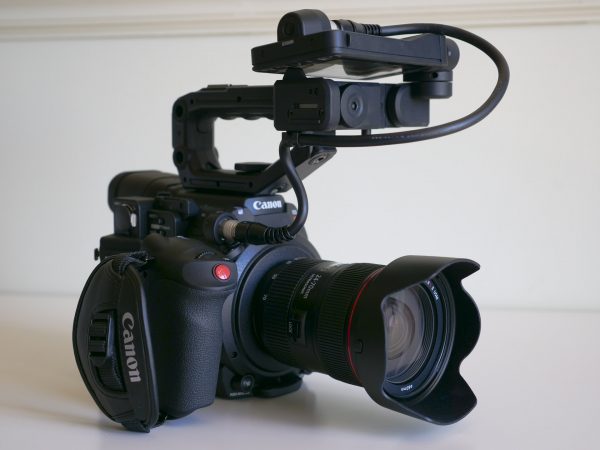
Colour depth is limited to 4:2:0 when recording MP4 files to the internal SD cards, although 4:2:2 is apparently output over SDI on a clean feed for external recording. Canon say that they like the MP4 format as it’s playable by a multitude of devices, and that in a world full of 8bit colour screens it makes sense to shoot in 8bit as well.
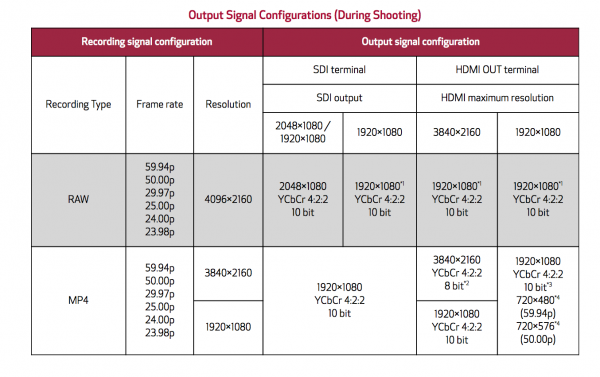
Above you can a list of the available output configurations when recording on the C200.

Bluntly though, it’s surprising to have such low data rates in a new camera released in 2017. The Sony F3 that was announced way back in 2010 was widely criticised for only having internal 4:2:0 35Mbps recording, and now Canon is doing the same thing seven years later. Upgrading from a C300 Mk I for example, you’d lose the ability to record 50Mbps HD internally, which seems like a real missed opportunity that could rule out the C200 for broadcast use.
At the time of writing we’ve not seen any vision from the camera though – and for me Canon have managed to wring the most out of the bitrates in their other Cinema EOS cameras, especially if you’re able to get the picture how you want it in camera. So I’m not going to set the internet aflame with my indignation just yet.
XF-AVC coming in 2018, new framerate options
Interestingly, Canon also plan to add the XF-AVC codec from the C300 MkII at a later date – currently planned for the first half of 2018. Apparently the delay is due to the complexity of re-engineering a 10bit codec to play nicely in 8bit. So possibly it’s not going to offer a dramatic increase in quality of footage when it arrives. But there is a roadmap, it’s planned as a free update, and once implemented it means footage from the C200 should fit nicely within a C300 Mk II workflow.
4K shooting tops out at 60p: if you’re after true 4K slowmo Canon will happily point you in the direction of the C700. Good news for HD shooters though, as the C200 will record continuous 120p footage without a crop at 1920×1080.
The camera’s ISO rating ranges from 100 up to 102,400 and Canon claim that the footage is useable up to 32,000.
The C200 uses the same Dual Pixel CMOS AF that is found in the C100 Mark II, C300 Mark II and C700.
Updated Browser Remote Functions Including Focus Support
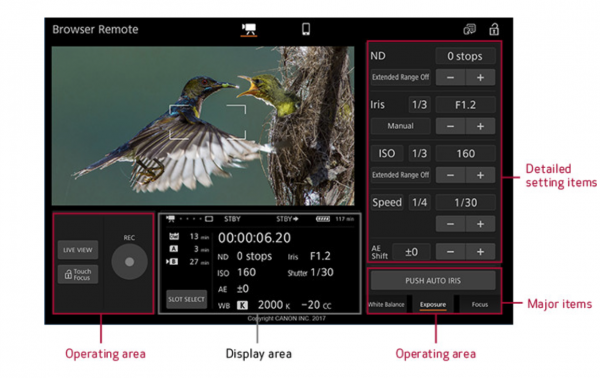
Multiple camera operations can be performed on the EOS C200 and EOS C200B from a connected device (such as a pc, tablet or iPhone) by accessing the Browser Remote with a general-purpose browser. A wide range of auto focus functions can also be controlled using the Browser Remote, including the ability to move the focus area with just a touch when using a tablet or iPhone.
Canon C200 price, availability and versions
The C200 will be priced at around £7,699 in the UK or $7,499 US in the States and is slated for release in July. It fills a hole in the Canon Cinema EOS lineup between the entry-level C100 MkII and what Canon are positioning as the more broadcast ready C300 MkII.
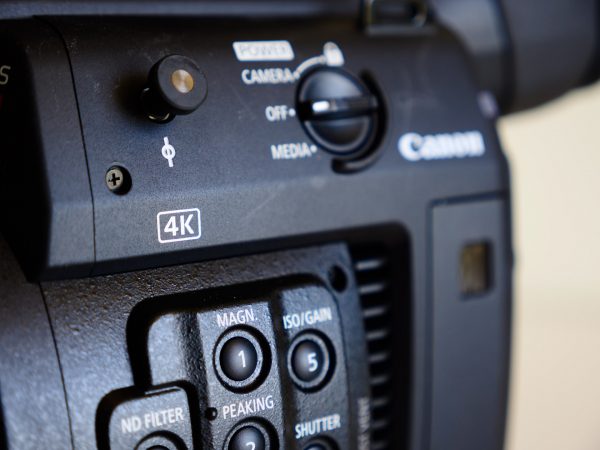
The C200 feels solid in the hand and the form factor at least seems to be the result of listening to what customers say they have been wanting. The same can be said of the framerates – 4K 60p and HD 120fps, from Canon, in an affordable package! And the appeal of a native EF mount with no adapters necessary shouldn’t be underestimated. But there’s always a but – and it feels like Canon are going to have to work hard to persuade buyers that their recording formats and bitrates can live up to the promise of the hardware.
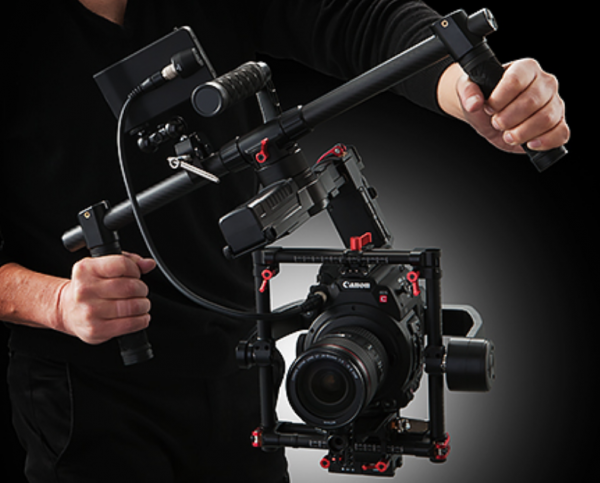
The C200 will be available in a kit with the 24-105 L II lens for £8,589.99, and also as the C200B. This is a stripped down version optimised for use on gimbals or remote mounts that ships without monitor, viewfinder, grip or handle. It will retail for $5,999 US.
Let us know what you think below, and if there’s anything else you’d like to know about the Canon C200. Erik is lining up an interview at Cine Gear so if we can’t answer now, we should be able to as the show gets underway.
Camera
Image Sensor
Sensor Super 35mm type CMOS
System RGB primary colour filter (Bayer array)
Total pixels per sensor Approx. 9.84 megapixels (4206 x 2340)
Effective pixels per sensor Approx. 8.85 megapixels (4096 x 2160): When 4096 x 2160 or 2048 x 1080 is selected as the resolution
Approx. 8.29 megapixels (3840 x 2160): When 3840 x 2160 or 1920 x 1080 is selected as the resolution
Signal-to Noise Ratio 50.00 Hz mode: 53 dB (Typical)
[3840×2160/25.00P, Canon Log 3 Base sensitivity ISO800 (Dynamic range
1600%),HDMI OUT]
Dynamic Range 15 Stops (CinemaRAW Light)13 Stops (MP4/Canon Log3)
Image Processor
Type Dual DIGIC DV6
Lens
Lens Mount Canon EF Mount
Lens Magnification Factor (for EF Mount lenses, including Cinema Primes) At 4096 x 2160 or 2048 x 1080 resolution: Actual focal length x approx. 1.460
At 3840 x 2160 or 1920 x 1080 resolution: Actual focal length x approx. 1.534
Changeable Lens Mount Yes, mount change to PL mount possible via Canon Service centre (Paid for service)
Peripheral illumination correction Yes with compatible lenses
ND filter Clear,2,4,6,8,10-stop
Focus control Manual via lens, manual via RC-V100 Auto Focus (Dual Pixel AF Approximately 80%(vert.),80%(horiz.))
Iris control Manual Via camera body or RC-V100, fine, 1/2 or 1/3 step increments, Auto (with compatible lenses), Push Auto Iris
Image stabilization system Depends on lens used
Recording
RAW Recording options RAW (Cinema RAW Light)
Internal Recording Cinema RAW Light, MP4
Recording time (CFast 2.0™card) 128GB card 15 Mins (4K Cinema RAW Light 1Gbps VBR)
Recording time (SD Card) 128GB card 110 mins (MP4, 150Mbps) 485Mins (MP4, 35Mbps)
Recording Formats Cinema RAW Light, (CFast 2.0™¹) MP4 XF-AVC (SD card. XF-AVC²)
Recording Frame Rate (1) 59.94 Hz mode (59.94P/29.97P/23.98P)
(2) 50.00 Hz mode (50.00P/25.00P)
(3) 24.00 Hz mode (24.00P)
Slow/Fast motion YES
Interval Record YES
Frame Record YES
Pre Record (cache record) YES, 3 seconds
Relay Recording YES, SD Card recording only
Double Slot (simultaneous) Recording YES, SD Card recording only
Scan Reverse NO
HD->SD conversion NO
Photo storage media SD Card
Photo Recording Size 2048×1080 (when video image resolution is 4096×2160/2048×1080)
3840×2160 (when video image resolution is 3840×2160)
1920×1080 (when video image resolution is 1920×1080)
System
Wave Form Monitor YES
Colour Bars YES, SMPTE / EBU / ARIB
Peaking YES
Zebra YES. Zebra 1 Level 5 ±5% to 95 ±5% in 5 percentage point intervals (70 ±5%)
Zebra 2 Level: 0% to 100% in 5 percentage point intervals (100%)
Markers YES, Centre, Horizontal, Grid Aspect Ratio(4:3 / 13:9 / 14:9 / 16:9 / 1.375:1 / 1.66:1 / 1.75:1/1.85:1 / 1.90:1 / 2.35:1 / 2.39:1 / Custom), Safe Area (80% / 90% / 92.5% / 95%)
EVF
Built- In EVF YES. 1.77M dots
Optional EVF Accessory Canon EVF-V70 (Also requires CL-V2 bracket)
Display Panel
Display Panel 4 inch/10.1cm diagonal LCD Monitor. Touch panel. Approx., 1.23M dots
Inputs/Outputs
Audio in XLR x2, 3.5mm Audio, AES/EBU digital or Analog Audio input, Line, Mic, +48V Phantom Power supported
Headphone output YES
HDMI YES, HDMI 2.0, output only. Max. output resolution 3840 x 2160.Timecode out compatible
USB YES. Mini-B Hi-Speed USB
3G/HD-SDI output YES x 1.BNC jack
Video [HD]:SMPTE 292. [3G]:SMPTE 424, SMPTE 425
Audio [HD]:SMPTE ST 299-1. [3G]:SMPTE ST 299-2, Output impedance 75 Ω, Output signal level 0.8 Vp-p
Time code NO
Genlock NO
Synch NO
Component out NO
AV terminal NO
DC Output NO
DC input YES, 14.4V DC (Battery), 16.7V DC (DC-In)
Power Consumption 50.00P: Cinema RAW Light/MP4; 18.5W (Approx.)
Continuous Recording Time (battery) BP-A30 (3100mAh) 130 Min (Approx.) BP-A60 (6200mAh) 280 Mins (Approx.)
Cinema Raw Light/4096 x 2160 or MP4/3840 x 2160 recording
Remote Control Terminal YES, 2.5mm proprietary connector
Wireless Control Terminal Built-in Wi-Fi. FTP and Browser Remote/Preview
Lens terminal NO
Ethernet terminal YES. FTP CAPABLE, MP4 files only
Video connector (For Monitor or EVF) YES, Canon proprietary connection
Misc.
Tally lamp YES
Custom Dial YES
Shooting functions
Exposure
Exposure metering (a) Standard (centre-weighted metering)
(b) Spotlight
(c) Backlight (compensation)
Exposure compensation AE shift function . The target value (±8 steps from centre) for the
brightness can be set. Indicated as exposure values (EV). (±2.0, ±1.75,
±1.5, ±1.25, ±1.0, ±0.75, ±0.5, ±0.25, and ±0) are displayed on the screen as AE
[numerical values]
Push Auto Iris YES
Exposure Lock NO
Auto Gain Control setting NO
ISO Sensitivity 1-Stop Display: [100], 160(*), 200, 400, 800, 1600, 3200, 6400, 12800, 25600, [51200,102400]
[—] Displayed when ISO speed expansion is ON. (*) Displayed when ISO speed expansion is OFF.1/3 Stop Display: [100,125], 160, 200, 250, 320, 400, 500, 640, 800, 1000, 1250, 1600, 2000, 2500, 3200, 4000, 5000, 6400, 8000, 10000, 12800, 16000, 20000, 25600, [32000, 40000, 51200, 64000, 80000, 102400] [—] When ISO speed expansion is ON.
Gain setting [-6dB,-3dB], -2dB(*), 0dB, 3dB, 6dB, 9dB, 12dB, 15dB, 18dB, 21dB, 24dB, 27dB,
30dB, 33dB, 36dB, 39dB, 42dB, [45dB, 48dB, 51dB, 54dB]
[—] Displayed when ISO speed expansion is ON. (*) Displayed when ISO speed expansion is OFF.
When ISO speed expansion is ON: between -2 dB and 54 dB
When ISO speed expansion is OFF: Any value from -2 dB to 42 dB in 0.5 dB
increments can be set.
Auto Focus System Dual Pixel CMOS AF supported
Manual focus, one-shot AF, continuous AF, AF-Boosted MF,
face detection AF (only lenses that support AF functions can be used
in any of these modes), focus guide
AF Frame Sizes Large; size equivalent to approx. 20% (vertical) x 25% (horizontal) of the image display
range; Small; size equivalent to approx. 20% (vertical) x 8% (horizontal) of the image display range
Auto Focus Modes One-Shot AF, Continuous AF and AF-Boosted MF are the available modes. All of these
modes take effect when the AF/MF switch of the EF lens is at the AF setting.
One-Shot AF: AF is performed only while the one-shot button to which it has been assigned is held
down. No further lens movement is permitted after focusing.
Continuous AF: AF control is performed at all times.
AF-Boosted MF
Face Detection AF Available; face Priority or Face Only.
Face Priority: AF is set to face frame when a face is detected, to tracking frame when tracking, and AF frame when there is no face or tracking.
Face Only: Switches to face frame when a face is detected, to tracking frame when
tracking, and MF when there is no face or tracking.
In both Face Priority and Face Only, the face to detect can be selected with the joystick.
Focus Guide Available; displays focus status or unfocused status using the AF signal.
Shutter speed
Control Modes Manual only
Shutter speed 1/3 stop display: 1/1, 1/1.26, 1/1.59, —, 1/1600, 1/2000 (total of 34 settings)
1/4 stop display: 1/1, 1/1.19, 1/1.41, 1.68 —, 1/1700, 1/2000 (total of 45 settings).
The slowest speed will differ depending on the frame rate setting.
Shutter Angle 360.00, 240.00, 180.00, 120.00, 90.00, 60.00, 45.00, 30.00, 22.50, 15.00, 11.25
Also, angle values equivalent to 1/120, 1/60, 1/40, 1/30, 1/100, 1/50, 3/100, and 1/25
are selectable within the minimum angle range from 360°.
Slow Shutter (SLS) 59.94(i/P) : 1/4, 1/8, 1/15, 1/30
29.97P frame rate has been set: 1/4, 1/8, 1/15
24.00P or 23.98P: 1/3, 1/6, 1/12
Clear Scan 24.00 Hz* to 250.40 Hz
(*) The frequency will differ depending on the frame rate setting.
Custom Picture
Stored Configurations PRESET: Canon Log 3/Canon Log /BT.709/Off
GAMMA: Canon Log 3/Canon Log/Wide DR/Normal 1 (Standard)/Normal 2 (x4.0)/Normal 3
(BT.709)/Normal 4 (x5.0)
COLOUR MATRIX: Neutral/Production Camera/Cinema EOS/Original /Video/ Off
Storage Medium Internal, SD Card
Master Pedestal 0 ± 50
Master Black Red 0 ± 50
Master Black Green 0 ± 50
Master Black Blue 0 ± 50
Black Gamma 0 ± 50
Low Key Saturation 0 ± 50
Knee Point + 50 – 95 – +109
Knee Slope -35 – 0 – +50
Knee Saturation 0 – ±10
Sharpness Level -10 – 0 – +50
Noise reduction Off / 1 – 12
White balance Red/Blue Gain 0 – +50
Setup level (0 – ±50)
Wi-Fi & GPS Specifications
GPS Information (Optional Accessory) Location (latitude, longitude and altitude) and GPS information using
Coordinated Universal Time (UTC) can be added to RAW movies, MP4 movies and photos. Satellite data acquisition status can be checked in camera mode.
W-Fi Specification Standard: IEEE 802.11b/g/n (2.4 GHz band), IEEE 802.11a/n (5 GHz band) (not supported in Qatar, Indonesia or Iraq) IEEE 802.11b/g/n (2.4 GHz band) IEEE 802.11n/11a (5 GHz band): Differs depending on the model’s destination.
Authentication: Open system, WPA-PSK, WPA2-PSK
Encryption systems: WEP-64, WEP-128, TKIP, AES
White balance
Auto YES. Shockless WB available
Preset Daylight (5600K), Tungsten (3200K)
Manual Setting Preset A/B, Colour Temperature Setting: 2000K – 15000K
Black balance
Black balance adjustment Auto Black Balance Adjustment
Time code
Countup system Regen, RecRun, FreeRun, TC Hold. Drop Frame /NonDrop Frame ( DF/NDF) in 59.94P/29.97P mode only
Audio
Recording Cinema RAW Recording: Linear PCM: 16-bit / 48 kHz / 4 channels
MP4: MPEG-4 AAC-LC (16-bit / 48 kHz / 2 channels), Linear PCM (16-bit / 48 kHz / 4 channels)
Accessories
Supplied LCD Monitor LM-V1 , LCD Attachment Unit LA-V1, Handle Unit HDU-2, Mic holder unit,
Thumb rest, Eyecup, Shoulder strap (SS-1200), Battery Charger CG-A20,
Compact Power Adapter, CA-CP200B, AC Adapter CA-A10, AC cable x 2, Ferrite core,
Battery pack (BP-A30) ,Unit Cable UN-5 , Allen wrench, bolts
Optional Canon Battery Pack BP-A30 (provided with camera)/BP-A60
Canon Battery Charger CG-A10/ CG-A20
Canon LCD Monitor LM-V1
Canon LCD Attachment Unit LA-V1
Canon Clamp Base CL-V2
Canon Camera Grip GR-V1
Canon Handle Unit HDU-2
Canon OLED Electronic View Finder EVF-V70
Canon Shoulder Support Unit SU-15
Canon Rod Clamp RD-1
Canon AC Adapter CA-A10
Canon Compact Power Adapter CA-CP200B
Canon Unit Cable UN-5/UN-10
Canon Remote Controller RC-V100
Canon GPS Receiver GP-E2
Canon Shoulder Strap SS-1200
Canon EF lenses, EF cinema lenses (EF mount)
Miscellaneous
Dimensions (Main Body Only) Approx. 144 x 153 x 179 mm (5.7 x 6.0 x 7.0 in)
Approx. 178 x 153 x 204 mm (7.0 x 6.0 x 8.0 in) [With camera grip attached]
Weight (Body Only) Approx. 1430g (3.2lb)
Weight ( Supplied Accessories) Camera Grip GR-V1: Approx.260 g (9.2 oz.)
LCD Monitor LM-V1: Approx. 185 g (6.5 oz.)
LCD Attachment Unit LA-V1: Approx. 255 g (9.0 oz.) Mic holder unit: Approx. 50 g (1.8 oz.)
Handle Unit HDU-2: Approx. 220 g (7.8 oz.)
Hex Socket Head Bolt:Approx. 5 g (0.18oz.)
BP-A30: Approx. 225 g (7.9 oz.)Unit Cable
UN-5: Approx. 80 g (2.8 oz.)
Thumb rest: Approx. 10 g (0.35 oz.)
Eyecup: Approx. 25 g (0.88 oz.)
Operating Temperature range Approx. 0 to 40°C, 85% (relative humidity)
Approx. -5 to 45°C, 60% (relative humidity)



